Biopsych and learning final exam
0.0(0)
0.0(0)
Card Sorting
1/352
Earn XP
Description and Tags
Study Analytics
Name | Mastery | Learn | Test | Matching | Spaced |
|---|
No study sessions yet.
353 Terms
1
New cards
What is learning?
The acquisition of knowledge or skills through experience
2
New cards
What is non-associative learning?
The ability to notice events and learn to ignore events that occur without consequence
3
New cards
What is associative learning?
Learning what stimuli predict events and what behaviours are associated with certain consequences, so that we are able to seek/avoid them
Classical conditioning
Classical conditioning
4
New cards
How can we tell that a behavioural change isn't learning?
It is not a consequence of experience and it is often temporary
5
New cards
What is the main difference between associative and non-associative learning?
Associative is when a new response is associated with a particular stimulus and non-associative is when learning results in a change in frequency or amplitude of a behaviour/response after repeated exposures to a stimulus
6
New cards
What are examples of non-associative learning?
Habituation (decrease in response) and sensitisation (increase in response)
7
New cards
What is habituation and how does it occur?
Decrease in responding after repeated experience with a stimulus. This usually happens when a stimulus is judged to be unimportant and is stimulus-specific.
8
New cards
What is sensory adaptation and how is it different to habituation?
It is a physical, bottom-up process where sensory receptors fatigue and stop responding to an unchanging stimulus. It is different to habituation because you cannot recapture the stimulus.
9
New cards
what is an example of sensory adaptation
Jumping into a cold pool, after a certain amount of time you cannot feel the cold rush again when you jumped in
10
New cards
what is dishabituation?
the recovery in responsiveness to an already habituated stimulus. this happens when a novel stimulus reorients the perceiver back
11
New cards
what is sensory specific satiety?
12
New cards
what is sensitisation?
Increased responsiveness to an event when we are anticipating an important stimulus. It is not stimulus specific
13
New cards
what is desensitisation?
a decrease in response amplitude or frequency down to baseine as a consequence of repeated experience with a stimulus
14
New cards
when will habituation occur over sensitisation?
low intensity = habituation
high intensity = sensitisation.
intermediate intensity = sensitisation and then habituation
high intensity = sensitisation.
intermediate intensity = sensitisation and then habituation
15
New cards
what were the results of the complex/simple pattern experiment with infants?
Attention elicited by a novel stimulus changes with familiarity. Simple = progressive habituation, complex = sensitisation and then habituation
16
New cards
How was dishabituation replicated in the lab?
a simple chequerboard stimulus was habituated, and then a tone was presented alongside it which caused a recovery of visual fixation to the pattern.
17
New cards
what is the dual process theory of habituation and sensitisation?
the observable behaviour is result of both processes. Habituation effect is observed when it is greater then sensitisation and vice versa
18
New cards
what is the key assumption of the dual-process theory of habituation and sensitisation?
habituation declines and grows stronger as the number of repetitions increase and sensitisation increases and then decays over time
19
New cards
what is classical conditioning?
associative learning. NS is paired with US, which has an UR. after conditioning US becomes CS and has the capacity to elicit a CR
20
New cards
what is NS
neutral stimulus
21
New cards
what is US
unconditioned stimulus
22
New cards
what is UR
unconditioned response
23
New cards
what is CS
conditioned stimulus
24
New cards
what is CR
conditioned response
25
New cards
What is an example of classical conditioning?
Pavlovs dogs. NS (metronome) initially gives no response. Paired with US (Food) which elicits salivation. After pairing, metronome elicits salivation.
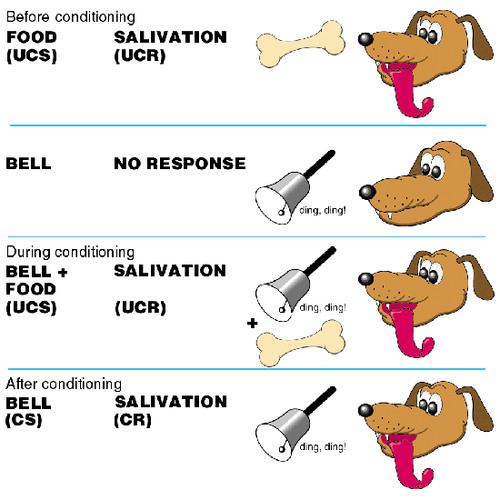
26
New cards
What are the three processes in classical conditioning?
acquisition, extinction and spontaneous recovery
27
New cards
what does the acquisition learning curve look like?
negatively accelerating. it is non-linear and asymptotic. learning continues beyond the asymptote but we can't measure it.
28
New cards
what are the two types of US?
appertitive = approach responses, elicit satisfaction and pleasure.
aversive = painful, harmful and elicit avoidance and escape responses
aversive = painful, harmful and elicit avoidance and escape responses
29
New cards
what is the acquisition difference between appetitive and aversive US?
Appetitive is slower and takes more trials to condition. Aversive can be established in only 1,2 or 3 trials depending on intensity
30
New cards
what is stimulus substitution theory?
Pavlov, believed that the CS became a subsitute for the US. The bell looks yummy. CR and UR produced by the same neural region.
31
New cards
what is evidence for the stimulus substitution hypothesis?
Jenkins & Moore 1973: sign tracking in pigeons. Pigeons given food as US tried to 'eat' the lit key, when given water they tried to 'drink'
32
New cards
what is the difference between sign-trackers and goal-trackers?
sign-trackers = direct their behaviour to the CS (eg light) even at the expense of the US (reward)
goal-trackers = direct their behaviour to the US (reward)
goal-trackers = direct their behaviour to the US (reward)
33
New cards
How does sign-tracking link to addiction?
CS that signal reward can become motivational magnets that capture attention even when they are trying to ignore them.
34
New cards
what is the evidence against stimulus substitution theory?
any study where the CR is different to the UR. when a tone is paired with shock, rats will jump to the US (shock), but the CR is typically freezing
35
New cards
what is the preparatory response theory?
Kimbles 1961,67: CR is a response that serves to prepare the organism for the US.
36
New cards
what is the compensatory response theory?
one version of the preparatory response theory. based on the opponent theory of emotion/motivation and the central goal is to maintain a state of homeostasis.
37
New cards
what is stimulus generalisation?
the tendency for similar stimuli to produce the same, but not necessarily identical, response
38
New cards
What is stimulus discrimination?
a differentiation between two similar stimuli when only one of them is consistently associated with the unconditioned stimulus
39
New cards
what is a study on stimulus discrimination?
Pavlov conditioned dogs to salivate to a tone of 1000Hz. Found that they also responded to tones around it, in a bell shape (closer to the tone more response)
40
New cards
what is transfer of training?
Being able to apply knowledge gained in one situation to that of a similar one.
41
New cards
What is higher order/second-order conditioning?
occurs when a strong conditioned stimulus is paired with a neutral stimulus, causing the neutral stimulus to become a second conditioned stimulus.
Stimulus to stimulus conditioning
Stimulus to stimulus conditioning
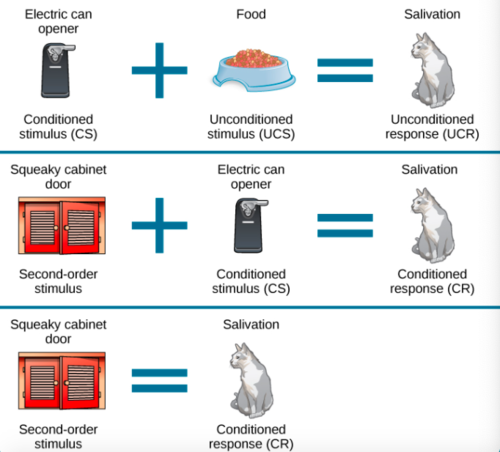
42
New cards
what are some limitations to higher-order conditioning?
the new pairing is approx 50% as strong as the original pairing. it is also difficult to accomplish because conditioned inhibition also arises, more common
43
New cards
what is sensory preconditioning?
pairing the two NS together before classical conditioning. this then results in both being conditioned at the end.
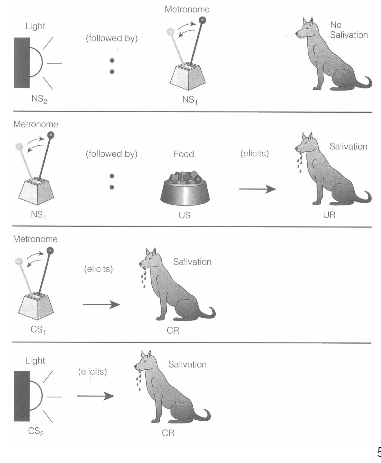
44
New cards
How can sensory preconditioning be done best?
first CS must precede second CS. One needs to predict the other (contingency) and only do a few CS to CS pairing otherwise learned irrelevance
45
New cards
what is the difference between sensory pre-conditioning and second-order conditioning?
phase 1 and 2 are swapped. SP phase 1 is pairing the US together and SO phase 1 is the classical conditioning
46
New cards
What is overshadowing?
conditioning with two stimuli simultaneously present. The more salient stimulus overshadows the less salient stimulus. the more faint one no longer gives a response on its own.
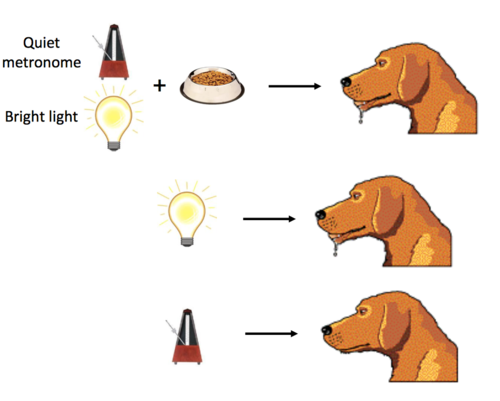
47
New cards
what is blocking?
One stimulus is conditioned first, and then two are presented simultaneously. the original CS still gives a response but the other US is blocked from learning, it does not give any more learning information.
48
New cards
How can overshadowing being used for maladaptive associations?
eg taste aversions during chemotherapy. A strong flavoured food is eaten with each chemo session so that there is an association between them, which overshadows other foods so they don't get associated with nausea.
49
New cards
what is latent inhibition?
the capacity to screen out stimuli that are considered irrelevant, if the NS is presented without the US prior to the conditioning training, conditioning is impaired.
50
New cards
what is the impact of the intensity of a stimulus on classical conditioning?
more intense CS are more effective in speeding up the acquisition, so fewer trials needed.
more intense US are especially powerful and can produce PTSD
more intense US are especially powerful and can produce PTSD
51
New cards
what is an excitatory stimulus?
the CS predicts the occurence of the US, positive relationship
52
New cards
what is an inhibitory stimulus?
when the CS predicts the absence of the US, negative relationship
53
New cards
why predict the absence of something?
we need to know alternatives and when we're safe
54
New cards
what is simultaneous conditioning?
CS and US are presented at the same time. very little conditioning is established
55
New cards
what is delayed conditioning?
CS is presented alone for a while, and then US is presented. Both are terminated together. the most effective
56
New cards
What is trace conditioning?
CS begins and ends before US is presented. the ease of conditioning depends on the length of the trace
57
New cards
what is backward conditioning?
CS is presented after US is terminated. no conditioning occurs because CS can't predict US
58
New cards
What happens when the delay between CS and US is longer?
Pavlovs dogs, 10 second tone (CS) and the food delayed (US). over time they began to estimate the delay, so only started salivating after 8-9 seconds
59
New cards
what is the extinction paradigm?
repeatedly present CS without the US. eventually it stops being a predictor of the US and CR decreases and eventually stops
60
New cards
what is spontaneous recovery?
after extinction, if there is a delay, the CS will often produce a weak CR
61
New cards
what is the relearning/reacquisition effect?
after CR is extinguished, fewer trials are needed to recondition the pairing.
62
New cards
what is the most important factor to determine the rate of extinction?
the total duration of exposure, not the number of times they have been exposed
63
New cards
what is external inhibition?
the presence of a novel cue during conditioning inhibits the CR, eg pavlovs dogs did not salivate when they were in front of an audience.
64
New cards
what is conditioned inhibition?
learning that an event signals the absence of the unconditioned stimulus, eg sign saying keep out
65
New cards
what is inhibition of delay?
a CR is withheld until an appropriate time (eg Pavlovs dogs salivating in the delay)
66
New cards
What is disinhibition?
removal of inhibition by the presentation of a novel stimulus
67
New cards
what is contiguity?
The more closely together (contiguous) in space and time two items occur, the more likely they will be associated. this is not accurate, backward and simultaneous are not good. (delay and trace do prove it though)
68
New cards
What is contingency?
the predictability of the occurrence of one stimulus from the presence of another
69
New cards
what is contingency theory?
a conditioned response (CR) develops when the conditioned stimulus (CS) is able to predict the occurrence of the unconditioned stimulus (US)
70
New cards
what effect does surprise have on learning?
you either get more or less then what you expected, so you increase or decrease your expectations as necessary, learning occurs
71
New cards
what two factors does contingency depend on?
reliability (how often is the CS followed by the US and what is the prob that the US will occur given that CS has occurred?)
Uniqueness (how often does US happen without CS and. what is the prob of the US occurring given that no CS has occurred?)
Uniqueness (how often does US happen without CS and. what is the prob of the US occurring given that no CS has occurred?)
72
New cards
What is Rescorla's equation?
the probability of of US occurring given that a CS is present is greater then the probability of a US given that no CS is present.
73
New cards
What does positive contingency look like for Rescorla's equation?
CS is a reliable predictor of the presence of the US, then the CS and US are positively correlated.
left hand is bigger then right hand
left hand is bigger then right hand
74
New cards
what does no contingency look like for Rescorla's equation?
CS is an unreliable predictor of the US, then the CS and US are not correlated.
both sides are equal, no learning
both sides are equal, no learning
75
New cards
what does negative contingency look like for Rescorla's equation?
CS reliably predicts the absence of the US, then the CS and US are negatively correlated.
right hand is bigger then left
right hand is bigger then left
76
New cards
what effect does positive contingency have on CC?
rat and bell experiment, bell becomes a fearful stimuli. more likely for shock to occur with bell then without
77
New cards
what effect does no contingency have on CC?
with or without bell has the same prob of shock, no learning
78
New cards
what effect does negative contingency have on CC?
shock is less likely to occur after CS, the bell becomes an inhibitory stimulus. (when the bell is heard, predicts no shock)
79
New cards
How is contingency calculated on a time diagram?
12 intervals of time. left side = see how many intervals with a CS, how many times does US occur? eg 4 intervals with CS and US occurs in all of them p = 4/4 = 1
right side= see how many intervals with no CS, how many times does the US occur in those? eg 8 intervals and US occurs in 2 of them p = 2/8 = 0.5
right side= see how many intervals with no CS, how many times does the US occur in those? eg 8 intervals and US occurs in 2 of them p = 2/8 = 0.5
80
New cards
what is the Rescorla 1968 classic contingency experiment?
Training a conditioned emotional response in rats (CER).
Phase1: Operant conditioning to establish steady bar pressing
Phase 2: Classical conditioning to establish CER. Had tones which had a .4 prob of being shocked in. then in in the inter-tone interval each group had a different prob (0, .1, .2, .4)
Phase1: Operant conditioning to establish steady bar pressing
Phase 2: Classical conditioning to establish CER. Had tones which had a .4 prob of being shocked in. then in in the inter-tone interval each group had a different prob (0, .1, .2, .4)
81
New cards
what is an ideal suppression ratio?
the lower the better the suppression and greater the conditioning
82
New cards
what did the 1968 Rescorla classic contingency experiment find?
there were differences in conditioning. right hand side of the prob equation was different for everyone. those that had 0 prob of getting shocked in interval had strong fear when the tone was heard in comparison to 0.4 who had no fear.
83
New cards
How does the size difference between probabilities affect learning? Rescorla equation
the bigger the size difference the bigger the learning
84
New cards
what is the Rescorla-Wagner model?
A mathematical model designed to predict the outcome of classical conditioning procedures on a trial-by-trial basis
Learning will occur only when the subject is surprised, that is, when what actually happens is different from what the subject expected to happen
Learning will occur only when the subject is surprised, that is, when what actually happens is different from what the subject expected to happen
85
New cards
what are the six rules of the Rescorla-Wagner model?
1. strength of US is greater then expectation, all CS's will receive excitatory conditioning
2. the strength of US is less then expectation, CS paired will receive inhibitory conditioning
3. strength is equal, no conditioning
4. the larger the difference between the expectation and the US the more conditioning
5. more salient CS condition faster
6. if two or more CS presented together, subjects expectation will = total strength (excitatory and inhibitory cancel each other out)
2. the strength of US is less then expectation, CS paired will receive inhibitory conditioning
3. strength is equal, no conditioning
4. the larger the difference between the expectation and the US the more conditioning
5. more salient CS condition faster
6. if two or more CS presented together, subjects expectation will = total strength (excitatory and inhibitory cancel each other out)
86
New cards
How can the Rescorla-Wagner theory be applied to acquisition?
the fastest growth in excitatory conditioning happens in the first trial as the difference between the expectation and US gets smaller as the trials continue
87
New cards
Does learning really asymptote?
R-W mdoel says no learning after that, but the asymptote actually only reflects the behavioural response, learning might still be occurring.
88
New cards
How does the Rescorla-Wagner model explain blocking?
no conditioning occurs when an additional CS is added because there is no surprise, the strength of the subjects expectation matches the strength of the US
89
New cards
How does the Rescorla-Wagner model explain extinction and conditioned inhibition?
The strength of the expectation is now higher then the actual US, association between the CS and US decreases
this leads to CS to acquire some inhibitory conditioning
this leads to CS to acquire some inhibitory conditioning
90
New cards
How does the Rescorla-Wagner model explain combining CSs?
the expected US of both of the CS is roughly equal to total strength. this would mean that excitatory and inhibitory cancel each other out
91
New cards
What is the over-expectation effect?
If two CSs are conditioned separately and then together, the animal has an over-expectation about the size of the US, and both CSs will experience some inhibitory conditioning
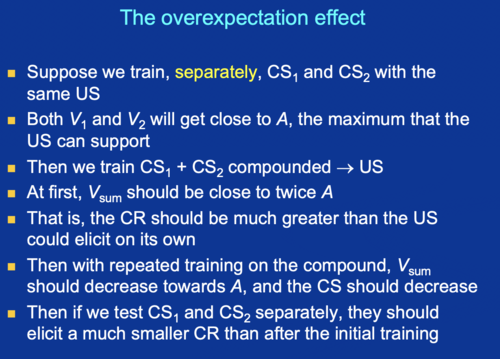
92
New cards
How does the Rescorla-Wagner model explain latent inhibition/pre-exposure effect?
It can't! When the NS is presented on its own, absolutely on its own, there is not meant to be any learning because actual = expected. subjects do learning something though because it reduces their ability to form an association between CS and US.
93
New cards
How do attention-based theories explain the pre-exposure effect?
CS predicts nothing during pre-exposure leading to attention decreases to the CS causing pairing to be slower
94
New cards
what are comparator theories of conditioning?
assume that two likelihoods are compared
1. US will occur in the presence of the CS
2. US will occur in the absence of the CS
1. US will occur in the presence of the CS
2. US will occur in the absence of the CS
95
New cards
how do comparator theories differ from attentional and rescorla-wagner theories?
1. they don't look at individual trials but instead of the overall long-term correlation between CS and US
2. the correlation of CS and US do not affect the learning of CR but rather the performance
2. the correlation of CS and US do not affect the learning of CR but rather the performance
96
New cards
How could we unmask learning in blocking?
induce blocking, have two stimuli but only one predicts because you don't get any extra information from the other. If the first stimuli is extinguished, then the other stimuli shows conditioning
problem is performance rather then learning, they had learnt the other could predict
problem is performance rather then learning, they had learnt the other could predict
97
New cards
how do comparator theories differ from Rescorla-Wagner model?
1. comparator assumes that both CS and contextual stimuli can acquire equal excitatory strengths, because both have been paired (blocking can be unmasked)
2. CS will not elicit a CR unless it has greater excitatory strength than the contextual stimuli
2. CS will not elicit a CR unless it has greater excitatory strength than the contextual stimuli
98
New cards
what is a common theme between attention theories, comparator theories and R-W?
1. predictiveness is a key determiner of whether Cr will occur
2. the predictiveness cannot be judged in isolation
3. stimulus must be compared to the predictiveness of other stimuli also present in the learner's environment
2. the predictiveness cannot be judged in isolation
3. stimulus must be compared to the predictiveness of other stimuli also present in the learner's environment
99
New cards
what is an attention based theory for classical conditioning?
Mackintosh (1975) Pearce and Hall (1980). focused on CS not US
Learner will pay attention to informative CSs but not informative CSs. Conditionability of CS changes from one situation to another.
Learner will pay attention to informative CSs but not informative CSs. Conditionability of CS changes from one situation to another.
100
New cards
What is Thorndike's Law of Effect?
If in a situation, a response is followed by a reinforcer, the response will become associated with that situation and will be more likely to occur again in that situation.